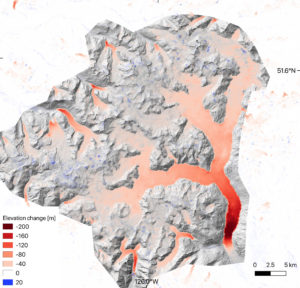British Columbia – which is over twice the size of California – contains around 17,000 glaciers that cover three percent of its landmass. These glaciers are crucial for the Canadian province, which relies on its many glaciers for everything from its water supply to the vast bulk of its power supply. The glaciers, of course, are also rapidly deteriorating in the face of global climate change. Now, researchers from four countries have used British Columbia’s own supercomputing resources to conduct the first comprehensive study of glacier retreat including all the world’s glaciers.
The research team – hailing from ETH Zürich, the University of Northern British Columbia (UNBC), the University of Oslo and the University of Toulouse – tracked glacial retreat by developing digital elevation models based on over 440,000 satellite images from NASA’s Terra satellite. Terra records stereo images – a boon for elevation analysis – and has been operating since 1999, allowing the researchers to go back decades in the past.
Image analysis was powered by UNBC’s Klinaklini supercomputer, itself named after the Klinaklini Glacier in British Columbia (pictured in the header). Klinaklini is a Dell system with 16 compute nodes and two Intel CPUs and 196 GB of memory per node, totaling some 1,024 cores and over three terabytes of memory across the worker nodes. With that computing power, the research team used the images to generate digital elevation models of the world’s roughly 220,000 glaciers.
“The UNBC and Hakai Institute computer facilities allowed us to generate time series of surface elevation, essentially time-varying topographies, at 100-metre resolution for about one-half of a billion individual locations over Earth’s glaciers and their surroundings,” elaborated Romain Hugonnet, the doctoral student at the University of Toulouse who led the research, which took years to complete – including 18 months of satellite data analysis.
“Processing spaceborne digital imagery to measure changes in surface elevation requires enormous computation power,” added Brian Menounos, a professor of geography at UNBC. “We needed an equivalent of about 584 modern computers running for about a year to derive these elevation models. Looked at another way, the generation of the elevation models required over five million compute hours.”

The researchers found that the past two decades had seen an average of 267 gigatons of ice lost from glaciers per year, which explained around 21 percent of sea level rise over the studied period. The melt accelerated as the years went on, almost hitting 300 gigatons per year by 2019. In Klinaklini’s home in the eastern Canadian Arctic, glacial loss contributed a staggering 21 percent of the world’s total. Alaska, Iceland, and the Alps appeared hardest-hit in terms of mass loss — but certain regions may stand to lose much more than just ice.
“The situation in the Himalayas is particularly worrying,” Hugonnet said. “During the dry season, glacial meltwater is an important source that feeds major waterways such as the Ganges, Brahmaputra and Indus rivers. Right now, this increased melting acts as a buffer for people living in the region, but if Himalayan glacier shrinkage keeps accelerating, populous countries like India and Bangladesh could face water or food shortages in a few decades.”
The team’s findings will be included in the next major report from the U.N. Intergovernmental Panel on Climate Change (IPCC) – a cornerstone of the climate science and policy world. “Our findings are important on a political level. The world really needs to act now to prevent the worst-case climate change scenario,” said co-author Daniel Farinotti, who leads the glaciology group at ETH Zurich.
Beyond the IPCC report, the researchers are hopeful that their findings will be useful for a variety of applications, including the improvement of hydrological models. “In addition to providing a detailed response of glaciers to regional and climate variability, the dataset will provide important observational data required to validate and improve physically-based models used to forecast changes in glacier and runoff in the decades ahead,” Menounos said.
About the research
The research discussed in this article was published as “Accelerated global glacier mass loss in the early twenty-first century” in the April 2021 issue of Nature. The paper was written by Romain Hugonnet, Robert McNabb, Etienne Berthier, Brian Menounos, Christopher Nuth, Luc Girod, Daniel Farinotti, Matthias Huss, Ines Dussaillant, Fanny Brun and Andreas Kääb and is accessible here.




























































